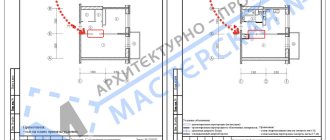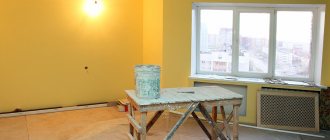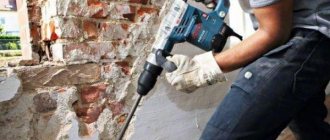assets/from_origin/upload/resize_cache/iblock/421/600_450_2/42190ed1a75fec22d035991d5c2876f8.jpg From this article you will learn:
- Where should the stages of apartment renovation begin, be it a resale or a new building?
- What are the stages of renovation in an old apartment?
- In what order should repairs be done in a new building?
- What little things to consider anyway
The need to renovate an apartment evokes a lot of different emotions in people. On the one hand, this is the anticipation of novelty, beauty and comfort, on the other – inevitable inconveniences, unforeseen expenses and eternal fears that the result will not coincide with expectations. In order to psychologically prepare for the upcoming interior remodel, it would be good to take a closer look at what stages of apartment renovation you will go through. This will help you decide whether you will try to realize your idea of an ideal home arrangement yourself or invite professionals.
Step-by-step apartment renovation from scratch: where to start?
When determining the sequence of actions when renovating an apartment,
start with the dirty work! These include:
- demolition of walls and partitions;
- cleaning surfaces from old coatings;
- removal of bulky waste.
Apartment renovation time frame
When starting your own work, know that there is no clear answer. But you can take the following steps as a working diagram:
- installation of an electrical network (without light, it will not be possible to provide normal working conditions for any team);
- installation of windows and entrance door;
- dismantling old and installing new plumbing;
- changing radiators and meters;
- replacement of interior doors;
- work with flooring (dismantling and laying);
- finishing of ceramic tiles in personal hygiene rooms (bath, toilet, toilet) and kitchen;
- work on the ceiling and walls (painting, plastering, wallpapering).
Advice! If you need to carry out a major renovation, you will have to go through all the stages. And it’s better to have one team of craftsmen do it. Then both rough and fine finishing fit equally well.
Apartment renovation: stages and order of work
When the time comes for work in the apartment, defining the stages and order of the procedure is an important basis for achieving your goals. You should prepare for both the cosmetic and capital varieties.
TOP 7 stages of preparation for apartment renovation
Follow this simple plan and you will succeed:
- Consider what you'll do once you've determined which type suits you best.
- Determine who will do the repairs (yourself/a team/several craftsmen).
- Calculate your expenses. This can be done either independently or using special programs. For example, on the website of the Repair Master there is a calculator, when you enter basic data on the apartment, area, type of building and expected results, you will be given future costs that are as close as possible to real ones. Having received the total amount of finances, you can estimate whether you can handle such expenses. Although, it is often better to take out a loan from a bank, but carry out the work on time, without expecting deeper damage to surfaces, cracks, etc.
- Study the websites and offers of companies and repair teams. Choose the best one according to your taste or reviews from friends or based on reviews on Internet resources. Contact them, hold a meeting and let them calculate the costs, issue the amount and calculate the time for the work. If everything is suitable, sign an agreement, which must indicate not only all the services that will be provided, but also include general estimates and stipulate in writing the conditions for what will happen if a failure or force majeure occurs.
- Clear the premises. Remove old items and furniture that needs to be replaced. Put away the equipment. Remove everything from the walls, from pictures to sconces, clocks and mirrors. Remove the fasteners and bolts yourself (so as not to pay repair crews).
- Create a schedule for repairs. If you are a responsible apartment owner. Plan to observe the stages and level of cosmetic, major or VIP repairs.
- Accept work from the crew. Your apartment should simply shine after the renovation. If this is not the case, do not be afraid to voice your complaints. It's your money and right. Discuss the points you don’t like, as they will remain in your home.
Psychological approach to apartment renovation
To implement this TOP 7 stages of preparation for repairs (which are listed above), you need to prepare psychologically and have:
- Determination. Stop being afraid and take the first step! Then the second and third. And then everything will go like clockwork.
- Interest. Even if you don't have enough money, there are things you can save on. For example, cleaning the apartment before renovation on your own. Or create some decorative elements yourself. Sometimes, if you have a little experience, you can do the rough work yourself. Although this requires specialized knowledge and skills.
- Logic. You'll have to evaluate what needs replacing now and what parts could last just fine for another year or two.
- Tendency to delegate and abstract. This will be very useful. There will be many advisers among relatives, friends and acquaintances. You will have to learn to “move away” from their opinions and trust yourself. That's the minimum. Or leave everything in the hands of professionals. In this case, you save several vital resources: money, time, nerves.
How to begin apartment renovation step by step
When planning to change your home, remember the sequence of renovations in the apartment
. We are ready to give you a checklist of professional solutions in this area:
- start from the entrance and from the periphery to the center (entrance door, windows, renovation of utilitarian premises, improvement of living rooms);
- rough finishing (if you bought an apartment in a new building, get ready to adjust or redo this area);
- clean repairs.
Some of these actions are described above.
And yet, let's repeat.
No. 1. Drafting
When a designer takes on your home, it will truly be transformed. But for this, a design project must be “born into the world.” And then, based on it, purchase building materials.
List of materials for apartment renovation
Before performing this action, it is better to look on the Internet and check the cost. But it’s better to call the points where, in your opinion, the best prices! So you will also have to spend your time and effort on saving and preparing!
To ensure the same cost, and sometimes even cheaper, check with the contractor whether he works directly with suppliers of building materials. If yes, order turnkey repairs! This option is a discount on the services of workers + the purchase of materials by them.
No. 2. Dismantling works
If you have a cosmetic renovation, it is enough to remove the equipment, take out the furniture, remove the wallpaper or flooring (depending on what will be changed). And with a capital one, you have to leave the apartment “bare”.
No. 3. Installation of communications and windows
Installation of doors, windows and communication systems is carried out at stage 3. Now is the time to lay electrical networks, install heating and hot water pipes. And also install sewerage and water supply systems.
No. 4. Rough finish
Essentially, this is the leveling of all surfaces. Often the walls are leveled first. Plus - they plaster, especially if the work is carried out in a brick house. This work is not carried out in a panel house.
If the ceiling is not suspended, then it should also be plastered.
No. 5. Finishing work
This is something you “have to live with” - painted/pasted walls, laid material on the floor, etc.
How to make a modern renovation in an apartment
Deception 6: Payment for unfinished work
One of the reasons why it is necessary to include a clause in the contract on the acceptance of hidden work is to identify in the estimate what was not carried out. After laying the parquet, you will not be able to check whether the floor has been leveled. This also applies to many other work issues.
Ask for a clear report of each step before making repairs and check each step. This can be tedious for the customer and not always pleasant for the contractor, but if you don’t trust them, it’s better to be safe and check everything.
REFERENCE:
Unfulfilled work specified in the estimate leads to poor-quality repairs. A missed step can result in broken tiles and peeling wallpaper in a couple of months. And no one will redo such repairs.
What determines the sequence of renovations in an apartment?
There is a special sequence of repairs in an old apartment
and new.
For example, there is nothing in housing from scratch. Therefore, all stages will be completed, but perhaps even without dismantling. There are essentially no old surfaces.
A new building usually has an entrance door, metal-plastic windows and quite decent (lately) rough finishing. In this case, it is worth assessing the level of work performed by the repair teams. And, if everything suits you, continue finishing. But most often, owners change the front door. This is a special sequence for renovating a new apartment
in a new building, when there is no need to invest in rough finishing.
In the secondary, it’s unlikely that any of the stages will have to be changed. Especially if a major renovation is planned. During cosmetic treatment, the sequence varies depending on the action plan. Also, changes may depend on whether the owners stay in the (2, 3 or 4-room apartment).
But in any case, wallpapering and fresh painting of the walls are carried out at the end of the repair, so that the dust from installing the ceiling or transforming it does not settle on the above-mentioned surface.
There are several practical tips and even life hacks from professionals that will allow you not to disrupt the sequence of renovations in your apartment:
- Include money in your spending plan/budget for removal of bulky and regular construction waste.
- Remove the film from new windows and doors, as well as the glass on them, after the repair work is completed.
- In advance, even before installation, you must know all the features of the shower cabin, bathtub, where and what “wet appliances” will be placed. This will allow the repair team not to “go astray from the action plan” and not to redo the drainage and connection points.
- In order not to destroy the plasterboard walls, electrical work should be carried out along with the installation of these surfaces.
- When gating is planned, only vertical grooves can be carried out in a panel house.
- If you want to build a wardrobe, water heater into plasterboard walls, or hang a bookshelf, TV or kitchen cabinet, immediately notify the craftsmen. Otherwise, the wall may not withstand it over time. In this case, in order not to disrupt the sequence of actions, they will first install the embedded materials, and then install the plasterboard wall. The same thing applies to plans for heavy curtains and plasterboard ceilings.
- In order not to disrupt the sequence of repairs, the “principle of simultaneity” often works. For example, when replacing doors. If they are removed and installed, then in all openings of the apartment at once.
- Sometimes wall decoration is not the final stage. This is the case when you need to varnish the floor material. That is, first they scrape the parquet, seal the cracks, cover it with a primer and work on the wall. And only at the final stage the floor surface is varnished.
Cheat 8: Stealing Materials
Even if the client tried to protect himself and bought all the materials himself, repairmen may simply request the wrong number of bags of cement and take the extra ones for themselves. This happens very often. Moreover, the “saved” bags never sit idle. The team will be able to use them for repairs at another facility, including it in the price for another client. It turns out that 2 clients will pay for a bag of cement at once, which means the difference will go into the pockets of the repairmen.
How to protect yourself?
Protecting yourself from this fate is not easy. I recommend that customers familiarize themselves with the technical characteristics of the material. The manufacturer indicates the material consumption on each bag. Knowing the area of the apartment, you can roughly calculate how much putty or glue will be needed.
But don't overdo these calculations. The consumption indicated by the manufacturer is approximate. If it is necessary to level the walls, the plaster will be applied in 2 or even 3 layers. This can lead to problems with calculations.
Advice
Don't be afraid to ask about where and how much of something went. Be meticulous. This might save you some money.
Stages of apartment renovation with rough finishing
If rough finishing has already been done, remember: haste is a bad advisor. The level of task completion should be considered. If everything is in order, you can proceed to the next steps:
- Evaluate doors and windows. If necessary, replace them.
- Plaster, if necessary, the ceiling and walls.
- Paint or whitewash the ceiling.
- Carry out work on the flooring: lay boards or tiles.
- Treat the walls (whitewash, paint, wallpaper).
- Install permanent structures (kitchen furniture and built-in wardrobes).
- Install skirting boards.
If it is necessary to carry out rough repairs, work should be carried out without violating the sequence of stages:
- Take out everything old: from furniture to communications that need to be replaced.
- Floor screed. Leveling is the basis for a good floor covering. It can be wet or dry. The main thing is to choose the most suitable process. Because in the first option the drying process lasts at least 4 weeks, and in the second - only about 3 days.
- Alignment of walls. The correct wall geometry catches the eye of everyone: both owners and guests. Therefore, cement or gypsum based plaster should be in the hands of real professionals. The dry method of leveling walls is plasterboard. It is economical to use and allows installation in 24-48 hours.
- Working with the ceiling. At this stage there are also 2 types of alignment. When wet, drying time is a week. Before plastering, the ceiling is cleaned of dirt and dust. Then they prime. And only after that they level it out. The dry method is simply installing a suspended ceiling. The sequence is very simple: metal profile frame + drywall. Execution time – 1-2 days.
Therefore, it is possible to carry out rough repairs in a week, or in a month and a half.
Cheat 1: Cost of materials
After a couple of years of constant work in the repair industry, I made friends in the building materials sales industry.
Almost every experienced foreman has similar connections. Thanks to close cooperation and constant purchases, I can buy cement at a 20-30% discount. However, clients do not know about this because builders falsify receipts:
- The receipt indicates the real cost, although in fact the buyer was given a discount.
- The receipt indicates expensive material, but it is not used. Instead, a cheap analogue is used for repairs. This is fraught with poor-quality repairs, and not just lost money on consumables.
Important
Buy the materials yourself or have the builders check everything after purchase. This approach is more expensive, according to the masters; you will be confident in the quality of consumables.
Sequence of major renovation of an apartment
When working with housing, professionals most often have to deal with major repairs. Often owners have no time for cosmetic repairs - this is the result.
Therefore, you need to know the sequence of work during a major renovation of an apartment.
:
- Planning. Preparatory work (removing garbage, equipment, removing chandeliers, mirrors and everything “extra”). As a result, there should be “bare” walls and floor.
- Dismantling of unnecessary structures and communications. If the renovation is cosmetic, then you need to remove the wallpaper and linoleum. If it’s major, there’s more work. This could be dismantling partitions, heating systems, plumbing, replacing a toilet, bathtub, shower, etc.
- Repair and installation of communication systems. At this stage, radiators are replaced, hoods are installed and air conditioners are installed. Updated electrical wiring is also an important type of service at this stage.
- Surface finishing. Usually the rule is this: it must be carried out from top to bottom, from the ceiling to the floor. But more often, pasting and painting the walls is done at the final stage. As for surface treatment, first they are leveled (see above), then plastered, then puttyed and opened, as necessary, with a primer. And then (optional) - paint, wallpaper. At the end, the baseboards are installed.
Important! When making repairs in a multi-room space, you should start from the remote rooms, completing the repairs closer to the front door. In this case, excess garbage is not spread around the apartment as much.
Sequence of renovations in an old apartment
Often in the secondary market, your hands are more “free” regarding the creation of project documentation. Often, repairs are made first, and then the necessary documents are signed.
Important! We must remember that if unapproved changes are detected in the design or during repairs, you can get... a fine! And he's not small enough.
Some friends told us a story that a neighbor, due to increased audibility of sounds, filed a complaint against the residents upstairs. During the inspection by DEZ employees, it was discovered that there was simply no soundproofing layer in the above-mentioned apartment. People had to restore it. But after paying the fine.
The same goes for plumbing work. When carrying out such repairs, contact not only the repair teams, but also the housing office employees. After all, they are the ones who must have complete information about the central risers and other parts of the water supply system.
So we determine the sequence of repairs in the apartment from scratch
:
- Removal of old coatings.
- Change of double-glazed windows. After dismantling the old ones and installing new ones, they should be covered with thick plastic film. This helps prevent scratching and smudging during all types of services.
- Plastering. This procedure is not as simple as it seems. During the process, markings for the beacon profiles are carried out, the walls are treated with a primer, and the beacon profile is installed. And only then - covering the walls and slopes with plaster.
- Installation of electrical communications. We are talking about installing or replacing a heating system, laying or wiring electrical cables. Everything related to the Internet, telephone, alarm and TV is carried out at this stage. It is better if the wiring diagram is drawn in advance.
- Preparing the floor. First of all, we are talking about the screed. Also at this stage, a warm floor is installed or the surface is simply leveled.
- Door installation. Many teams like to install doors after changes have been made to the floor.
- Finishing work. There are variations here. For example, if you plan to whitewash and paint the ceiling, then do it first, and then finish the walls. If the plan is to install a suspended ceiling, then install it when the walls have already been finished.
- Installation of decor and small elements. We are talking about trims and sockets. Also at this stage the installation of skirting boards takes place. And in the kitchen and bathroom - small plumbing fixtures, faucets and various accessories.
Important! If this sequence is used as stages of turnkey apartment renovation
, then you should remember that real pros carry out the same steps throughout the room.
Hoax 9: Works Popping Up Out of Nowhere
Sometimes finishers “forget” to indicate an important stage of repair in the preliminary estimate. For example, plastering walls before wallpapering. When it comes to this stage, the client understands that it is impossible to do without it. This increases the final repair estimate.
It is because of such “forgotten” nuances that the final estimate can be 2-3 times higher than initially stated. Carefully read all stages of work before concluding a contract. It is also recommended that you familiarize yourself with certain documents that describe the regulations and quality for repairs:
- SNiP on Insulating and finishing coatings;
- SNiP on Internal sanitary systems;
- SNiP on Electrical Devices;
- GOST R52059-2003 on Services and housing repairs.
From them you can find out approximately what kind of work should be carried out and what quality standards are allowed for them. If you notice any deviations during the repair, ask the craftsmen to redo it. They are obliged to redo it free of charge, you will only have to pay for the re-taken materials.











